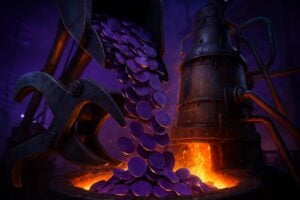The NFT market is still in deep crisis, with prices far from those of the boom.
Although July is not over yet, only two days are left, so the first conclusions can already be drawn.
The collapse of volumes and prices in the NFT market
The boom of the NFT market occurred during 2021, with the peaks reached in January 2022.
According to the data from CryptoSlam, in January 2021 the total monthly trading volumes of NFTs on the market surpassed 100 million dollars for the first time.
A year later, in January 2022, they had risen to over six billion dollars, or sixty times as much.
After this amazing growth, which lasted a year, a very long bear-market followed, which is still ongoing.
The minimum peak of monthly trading volumes in 2022 in the NFT market was recorded in October, with less than 600 million dollars, which is a drop of more than 90% in less than a year.
However, 2023 went even worse, with a drop to 300 million dollars in September.
At the end of 2023, it seemed, however, that it was recovering, with a rise above 1.7 billion dollars in December, but at that point, a new decline began that brought the monthly volumes back around 400 million.
Therefore, although the worst post-bubble month for now remains September 2023, the approximately 400 million dollars this July are significantly lower than the worst month of 2022.
The end of 2023 turned out to be just a flash in the pan.
Buyers and sellers
Crypto Slam also measures how many active public addresses are on the NFT exchange market.
In January 2021, there were very few, so much so that those data must now be considered absolutely outdated.
In April 2021, however, there were just under 500,000 active addresses both in buying and selling.
At the peak, in January 2022, the active addresses of sellers had risen above one million, while those of buyers had approached one and a half million. These, despite being all-time highs, still do not seem particularly significant numbers. It means that even during the last major bubble this was still just a niche market.
Also in this case, the post-bubble minimum peak was reached at the end of 2023, with fewer than 500,000 sellers in November, and fewer than 540,000 buyers in October.
In this case, however, the rebound in 2024 occurred, and it seems to be holding.
In February of this year, the sellers rose above 800,000, with the buyers rising to over 1.2 million. The even more curious thing, however, is that in July, for now, there have been only just under 370,000 active addresses of the sellers, while those of the buyers have remained just under 980,000.
The current prices of the NFT market
Despite the sharp drop in sellers, and the relative stability in the number of buyers, prices have returned to being low.
The point is that, probably, retail sales have decreased, but those of the original producers have remained high.
The buyers have decreased much less from the annual peak in February, but they have still decreased. And that’s why the volumes have remained low, despite the high number of buyers.
While on one hand such a picture does not seem to be comforting at all, on the other hand, the resilience of the number of buyers suggests that there might eventually be room for a new rebound.
It is worth noting that during the second quarter of 2024, ending in June, volumes decreased by 45% compared to the first quarter of the year, dropping from 4.1 billion dollars to 2.24 billion.
At the beginning, to tell the truth, there was a significant increase, particularly in the number of transactions, which rose from 5.7 million in June to 9.9 million transactions. This further certifies that the average price has dropped.
The future of the NFT market
Despite everything, the NFT market still seems to have a future.
In a recent interview, the founder of CryptoSlam, Randy Wasinger, stated that NFTs are not dead, and that, just like all digital assets on blockchain, they are here to stay.
The key point at this stage is the rotation between different sectors.
Wasinger in fact believes that some applications of NFTs, fueled by previous cycles of hype, might indeed never return, but other use cases could reach new peaks and bring this market back to previous levels.
One of the use cases that might disappear are the picture-for-profile (PFP), which might never again regain the level of adoption they had a year or two ago.
Instead, other use cases, such as those within Web3 apps, could continue to evolve positively.
Wasinger said:
“I don’t know if this will necessarily be reflected in large sales volume numbers like in the past, at least in the short term, but I foresee that it will manifest in perhaps greater transaction volumes”.









